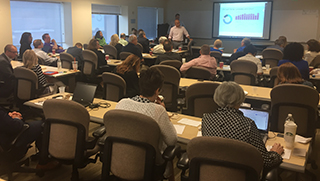Subscribe for Weekly Updates

NASBA 2017 Data Summit – Examining the Statistics
By Mylin Batipps Jr., PICPA public relations coordinator
CPAs from state accountancy boards, state societies, colleges and universities, and firms from all over the country came together to talk CPA Exam numbers at the National Association of State Boards of Accountancy (NASBA) 2017 Data Summit held June 21-22 at PICPA headquarters in Philadelphia.
 Representatives of NASBA presented data on the number of candidates nationwide who have taken the exam over the past decade, the pass and fail rates of those candidates, and a multitude of factors contributing to the rates and trends.
Representatives of NASBA presented data on the number of candidates nationwide who have taken the exam over the past decade, the pass and fail rates of those candidates, and a multitude of factors contributing to the rates and trends.
The goal of the summit was to dig into the national rates and determine the why behind the numbers. According to the educators, firm members, and accountancy board representatives, a variety of factors contribute to the number of candidates from year to year and the pass/fail rates and trends, including diversity demographics, the degree programs in which the candidates are involved, changes to the exam, and time.
A point emphasized at the summit was that there is a strong correlation between the number of those sitting for the CPA Exam and the date they graduated from college. The longer it has been since graduation from a college, the less of a chance those graduates will sit for the exam. Reasons range from decreased motivation, increased responsibilities, the distraction of life-changing events, among others.
Attendees also looked into the CPA Exam itself, specifically how its content areas and skills tests have changed. The number of content areas in each section of the exam are decreasing, but, conversely, the number of skill areas are increasing. Educators expressed a strong desire to leverage score data. Carlo J. Silvesti, CPA, an accounting professor at Gwynedd Mercy University, said he is interested in accessing the data to see where his students are succeeding and where they are falling short. “I want to dig in and see how my students have done,” Silvesti said. “We have a four-year, 150-hour program, and I want to see how they’ve fared. I would really like to see their strengths and weaknesses.”
Sheri L. Risler, CPA, a Temple University accounting professor and a member of the Pennsylvania State Board of Accountancy, has found the CPA Exam candidate statistics and learning about the exam changes to be useful. “As a new State Board of Accountancy board member, it’s really valuable for me to just learn about all the resources available from NASBA,” she said. ”As a faculty member, I look forward to using the various reports and information to help us continuously fine-tune our undergraduate and graduate curriculum to meet the needs of the CPA Exam.”
Diversity in the profession was an overarching theme discussed during the summit. Attendees explored reasons why rates have been so low as they relate to minorities taking and passing the exam, along with ways to help raise those rates. For instance, the process of preparing for the exam is one that is costly. This affordability issue may be preventing students in minority groups who may have an underwhelming support system from pursuing the exam. In addition, students of these groups are not as exposed to internship opportunities; thus, they may not be getting direct feedback as to what firm members want from potential hires.
State society members discussed increasing their efforts to approach students from colleges and universities and to offer information on scholarship and internship opportunities. They also suggested providing a platform for students to ask questions or express concerns. Representatives from national associations such as the AICPA, the National Association of Black Accountants, and NASBA discussed ways they can improve connections with students in high school, middle school, and even elementary school.
Courtesy of PICPA’s Inspire Future CPAs in the Classroom program, CPAs in the state have visited students at middle schools and high schools to not only present financial literacy tips, but also inform the students about the diverse career options that are available in the CPA profession. An even newer initiative that was launched this year is the Pennsylvania CPA Foundation, which aims to help increase the CPA profession’s visibility among young students of diverse backgrounds and to provide them with the resources necessary to consider accounting as a career, pass the CPA Exam, and enter the profession. Visit www.picpa.org/cpa-foundation to learn more about the Foundation and how you can contribute.







Leave a commentOrder by
Newest on top Oldest on top